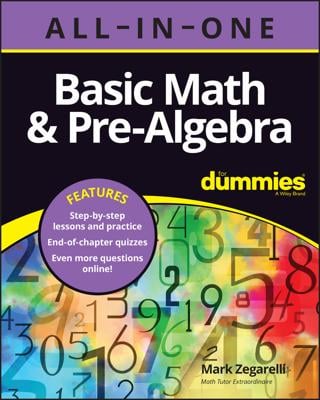Basic Math & Pre-Algebra All-in-One For Dummies (+ Chapter Quizzes Online)
Explore Book Buy On AmazonAdding fractions that have the same denominator (also called a common denominator) is super easy: Just add the numerators and keep the denominator the same. Sometimes you may have to reduce the answer to lowest terms or change it from an improper fraction to a mixed number.
Adding fractions that have different denominators takes a bit of work. Essentially, you need to increase the terms of one or both fractions so the denominators match before you can add. The easiest way to do this is by using a cross-multiplication trick that switches the terms of the fractions for you. Here’s how it works:
Cross-multiply the two fractions.
Multiply the numerator of the first fraction by the denominator of the second fraction and multiply the numerator of the second fraction by the denominator of the first.
Build two fractions that have a common denominator.
Multiply the denominators of your two original fractions to get the new, common denominator. Create two new fractions by putting your results from Step 1 over this new denominator.
Add the fractions from Step 2.
Add the numerators and leave the denominator the same.
When one denominator is a multiple of the other, you can use a quick trick to find a common denominator: Increase only the terms of the fraction with the lower denominator to make both denominators the same.
Sample questions
Find 5/8 + 7/8.

The denominators are both 8, so add the numerators (5 and 7) to get the new numerator and keep the denominator the same:

The numerator is greater than the denominator, so the answer is an improper fraction. Change it to a mixed number. The fractional part of this mixed number still needs to be reduced, because the numerator and denominator are both even numbers. Divide them both by 2 and repeat:

Add 3/5 and 14/15.

The denominators are different, but because 15 is a multiple of 5, you can use the quick trick described earlier. Increase the terms of so that its denominator is 15. To do this, you need to multiply the numerator and the denominator by the same number. You have to multiply 5 times 3 to get 15 in the denominator, so you want to multiply the numerator by 3 as well:

Now both fractions have the same denominator, so add their numerators:

The result is an improper fraction, so change this to a mixed number:

Practice questions
Add 7/9 and 8/9.
Solve

Find

Following are answers to the practice questions:
-

The denominators are the same, so add the numerators:

Both the numerator and denominator are divisible by 3, so reduce the fraction by 3:

The result is an improper fraction, so convert it to a mixed number:

-

The denominators are different, so change them to a common denominator by cross-multiplying. The new numerators are 3 x 11 = 33 and 4 x 7 = 28:

The new denominators are 7 x 11 = 77:

Now you can add:

-

The denominators are different, so change them to a common denominator by cross-multiplying. The new numerators are 5 x 10 = 50 and 7 x 6 = 42:

The new denominators are 6 x 10 = 60:

Now you can add:

Both the numerator and denominator are even, so reduce the fraction by 2:

They’re still both even, so reduce again by 2:

The result is an improper fraction, so change it to a mixed number:


